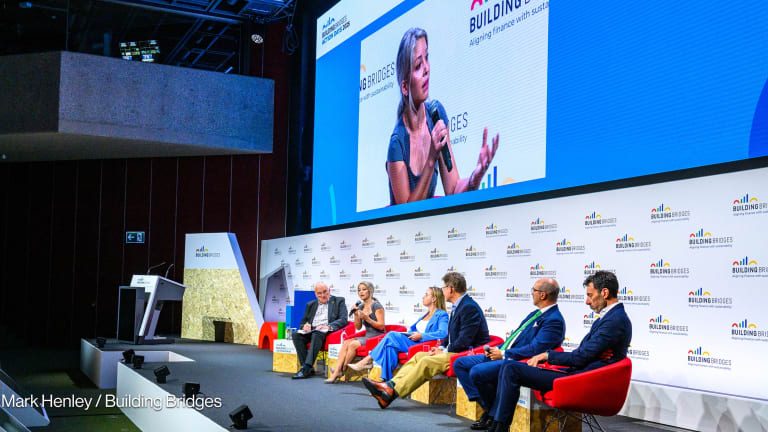
The latest ADB Country Operations Business Plans, or COBPs, for the 2017-2019 period accounts for over 800 projects worth more than $71 billion in ADB contributions. Devex aggregated and analyzed all the public information from the latest ADB COBPs and created an interactive visualization tool that allows individuals and firms to search for ADB lending or non-lending contributions by year, sector and location.
Here’s what you need to know about future ADB business opportunities.
ADB’s operations and business opportunities
According to the new ADB report Meeting Asia's Infrastructure Needs, infrastructure needs in developing Asia and the Pacific will require an investment of $26 trillion from 2016 to 2030, or $1.7 trillion per year. Aware of this reality, the ADB is expanding its operations. In 2016, ADB reached an all-time high of $17.5 billion in sovereign and non-sovereign project approvals, a 9 percent increase from $16 billion in 2015. By 2020, ADB is planning on increasing that figure to over $20 billion, thanks to the merger of ADB’s two main lending instruments: the Asian Development Fund and the Ordinary Capital Resources. This enhancement of the ADB financial capacity took effect on January 1, 2017, and it means donor contributions that replenished the ADF every four years will no longer be required to support concessional lending operations. The ADF is retained as a grant-only donor fund to provide grant assistance to the most debt-distressed countries in the region, and the generous concessional loans that it used to provide to low-income countries will be supported under the same conditions from the expanded OCR balance sheet.
According to the ADB, as of December 2016, the bank had a pipeline of $28.8 billion uncontracted loans and grants funds. These opportunities belong to projects that have already been approved by the ADB board and are currently in implementation. According to the ADB data, for the period 2007-2016, delays on contract awards and disbursements of approved projects is estimated to account between $1 and $5 billion every year.

These are the five countries leading on uncontracted opportunities: China with $5.5 billion, or 19 percent of the total; India, which represents 13 percent; Pakistan and Vietnam each accounting for 10 percent; and Bangladesh representing the 8 percent. The sectoral distribution of these business opportunities is: transport (30 percent), energy (27 percent), water and urban development (14 percent), agriculture (11 percent), and education (7 percent).
At Devex we know how important it is to identify opportunities early on to succeed in partnering with the ADB. To help you do this, we are providing up-to-date data on the upcoming projects through this interactive visualization. If you want to see all the listed details about the projects, you can click on specific countries or projects to be redirected to our Funding Activity Feed.
Devex analysis of ADB’s Country Operational Business Plans (2017-2019)
ADB publishes Country Operational Business Plans once a year with the list of the future lending and non-lending projects that the different sectoral and geographic divisions at the bank are preparing — meaning, projects that are not approved by the ADB board yet. For this analysis, Devex has taken into consideration the COBPs published in the second half of 2016 and early 2017, referring to the 2017-2019 period. It is worth noting that the 2017-2019 COPBs for Azerbaijan, China and Micronesia have not been published yet, and Devex can confirm they are still under preparation.
The ADB lending operations include contributions from the Ordinary Capital Resource, the Concessional Ordinary Capital Resource Loans, the Asian Development Fund Grants, and the Asian Development Fund Loans. The five countries with the biggest ADB’s forecasted lending portfolio according to the 2017-2019 COBPs are: India with 73 projects, accounting over $20 billion; Indonesia with $9.6 billion; Bangladesh with $6.2 billion; Pakistan with $6.1 billion; and Vietnam with $4.9 billion.

India leads the list, thanks to four urban transport projects: The Jaipur Metro Line 2 with a budget of $1 billion; two investment programs for the Mumbai’s Metro (Line 2A and 2B) with estimated budgets of $775 million and $625 million, respectively; and the $720 million investment program in Rajasthan State Highways. The other two biggest Indian loans are being prepared by the South Asia Energy Division at the ADB: the Interstate Natural Gas Pipeline ($750 million) and the Mumbai Efficiency Transport and Electricity Distribution Improvement project ($700 million). Indonesia follows with four projects on energy access and electricity grid development with a $600 million estimated ADB budget each.
Complementary to the lending portfolio, the ADB non-lending operations include several types of technical assistances: the Project Preparatory Technical Assistance; the Policy and Advisory Technical Assistance; the Research and Development Technical Assistance; the Capacity Development Technical Assistance; the Transaction Technical Assistance; and the Knowledge and Support Technical Assistance. Myanmar leads the non-lending portfolio in planning with $52 million for the three years period considered, followed by India with $18 million; Uzbekistan with $16 million; and Bangladesh and Cambodia with $15 million and $12 million, respectively. Despite this, in relative terms, the Pacific islands (Cook Islands, Marshall Islands, Solomon Islands, Tuvalu and Vanuatu) are the ones with higher ADB technical assistance contributions.

Regarding the priorities by sectors, our analysis confirms ADB’s focus on infrastructure. According to ADB’s data, opportunities in the transport and energy sectors account for 57 percent of the $28.8 billion approved but still uncontracted amount. For the 2017-2019 period, ADB’s forecasted contributions on loans and grants operations account for $71.1 billion, of which 56 percent are also transport and energy projects.

Do you have questions about our methodology or specific opportunity? Reach out to our experts at analysts@devex.com for more information.
Devex delivers cutting-edge insights and analysis to the leaders shaping and innovating the business of development. Make sure you don't miss out. Become a Devex Executive Member today.



